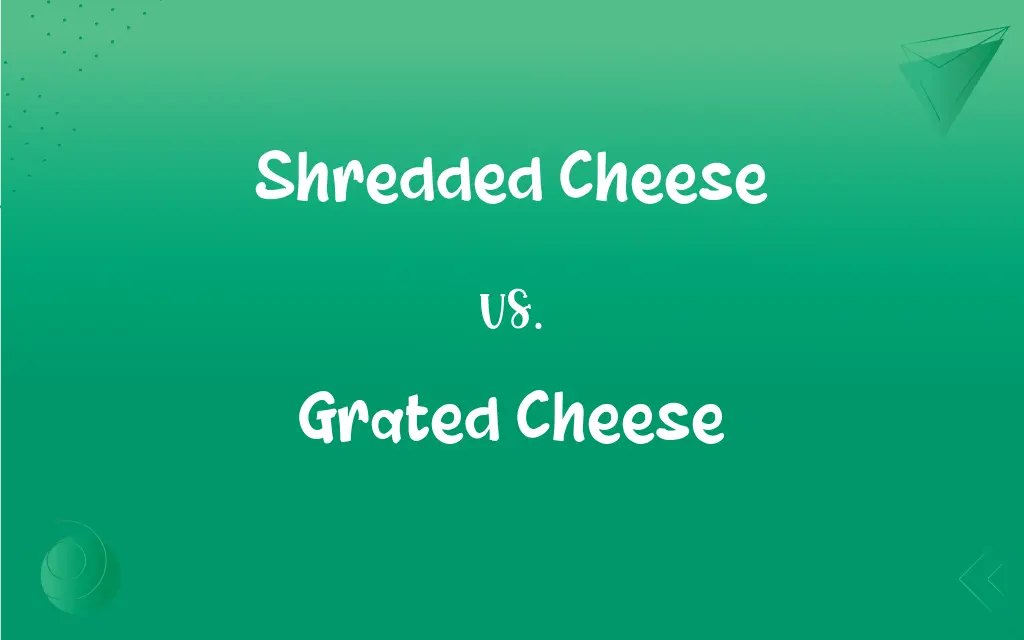Shredded Cheese vs. Grated Cheese: What's the Difference?
Edited by Janet White || By Harlon Moss || Updated on October 13, 2023
"Shredded cheese" is typically longer, thicker pieces, often resembling thin strips, while "grated cheese" results in smaller, finer pieces, almost powdery at times. Both are obtained by mechanically processing cheese.

Key Differences
The culinary arts employ a variety of techniques, among which the methods used to create "shredded cheese" and "grated cheese" are noteworthy. Shredded cheese typically presents itself as elongated, thicker strands, often achieved using larger holes of a grater. Contrastingly, grated cheese is generally characterized by its fine, almost powdery consistency, which is commonly obtained using the smaller holes on a grater. These subtle distinctions in physical appearance and texture between the two types of processed cheese carry implications for their respective culinary applications.
Exploring shredded cheese further reveals its versatility and prevalence in numerous dishes. It is often found atop pizzas, baked dishes, and casseroles, where its thicker, more robust strands can provide a delectable melt and appealing visual aesthetic. In a parallel culinary journey, grated cheese with its finer particles offers a quick and even melt, and often finds a home sprinkled atop pastas or integrated into sauces. Its minute particles facilitate a rapid integration into dishes, providing a smooth and even distribution of cheesy flavor.
When assessing the structural variances between shredded cheese and grated cheese, one recognizes the pivotal role of the grating tool in achieving the desired outcome. Larger, wider holes in a grater are typically employed to achieve shredded cheese, yielding strips that carry a perceptible, satisfying texture in various culinary creations. Conversely, to obtain grated cheese, smaller, finer holes or even a Microplane might be employed, resulting in a product that seamlessly incorporates into dishes, often providing a subtle, evenly-dispersed cheesy note.
Interestingly, shredded cheese often conveys a tactile, visually appealing element in dishes where the cheese is meant to be a standout feature. The recognizable, melt-y strands of shredded cheese often augment both the physical and flavorful dimensions of dishes, providing a texturally rich experience. Simultaneously, grated cheese, with its unassuming, finer structure, often bestows a more understated presence, melding smoothly into dishes to enhance their flavor profile without dominating the textural or visual landscape.
In reflecting upon shredded cheese and grated cheese, the understanding of their respective culinary applications is enlightened by their physical properties. Shredded cheese, with its thicker, more substantial form, provides a hearty cheese experience, whereas grated cheese, with its delicate and fine consistency, can subtly elevate a dish's flavor without altering its structural integrity. Both bring their unique attributes to the culinary table, offering chefs and home cooks alike varied options in tailoring their cheesy endeavors.
ADVERTISEMENT
Comparison Chart
Typical Appearance
Longer, thicker strands
Fine, powdery bits
Common Use
Topping for pizzas, casseroles
Mixing into sauces, topping for pasta
Grating Tool
Larger holes of a grater
Smaller holes/Microplane
Melt Quality
Noticeable, stringy melt
Quick, even melt
Texture Contribution
Texturally significant
Subtle, integrates smoothly
ADVERTISEMENT
Shredded Cheese and Grated Cheese Definitions
Shredded Cheese
Shredded cheese is cheese that has been passed through a shredder, creating long, thin strips.
She generously topped the pizza with shredded cheese.
Grated Cheese
In various recipes, grated cheese can dissolve or integrate into a dish without providing a stringy or gooey texture.
The grated cheese gently melted into the soup, providing a subtle, creamy texture without stringiness.
Shredded Cheese
It often appears in culinary contexts where a pronounced cheese presence is desired.
She sprinkled shredded cheese atop the chili for a hearty finish.
Grated Cheese
Grated cheese typically employs smaller holes on a grater or a Microplane for its production.
She carefully ran the block of Parmesan over the Microplane, producing a fine mound of grated cheese.
Shredded Cheese
It is typically used in dishes like pizzas, baked pasta, and casseroles where its melt qualities are showcased.
She layered shredded cheese between the pasta for a rich, cheesy lasagna.
Grated Cheese
It often finds use in culinary scenarios where smooth integration and subtle flavor enhancement are desired.
He sprinkled grated cheese over the salad for a delicate cheesy touch.
Shredded Cheese
Shredded cheese can provide a visually appealing and texturally distinct element in dishes.
The shredded cheese melted into long, gooey strands over the nachos.
Grated Cheese
Grated cheese often possesses a powdery or granular consistency, enhancing its melding properties.
The grated cheese seamlessly blended into the warm sauce, enriching its flavor.
Shredded Cheese
Shredded cheese generally exhibits a robust melt, forming stretchy, stringy layers in heated dishes.
The shredded cheese formed a deliciously gooey layer in the grilled cheese sandwich.
Grated Cheese
Grated cheese is cheese that has been mechanically processed into fine, small pieces.
Add grated cheese to the top of the pasta for extra flavor.
FAQs
What type of consistency does grated cheese have?
Grated cheese generally has a fine, powdery consistency.
Can you substitute grated cheese for shredded cheese in recipes?
Yes, but textures and melting qualities may vary in the final dish.
Is shredded cheese ideal for smooth sauces?
No, grated cheese is often preferred for smoother sauces due to its fine texture.
Can you use grated cheese in a grilled cheese sandwich?
Yes, but it may melt and spread more rapidly and finely than shredded cheese.
Does shredded cheese mix smoothly into sauces?
It can, but might provide a slightly less smooth texture than grated cheese.
What is shredded cheese commonly used for?
Shredded cheese is often used for toppings, like on pizzas or nachos.
Can all cheese varieties be grated?
No, extremely soft cheeses may be difficult to grate effectively.
Can you shred cheese without a grater?
Yes, using a knife or a food processor with a shredding attachment is possible.
Why might some prefer shredded cheese on pizza?
The larger pieces melt into gooey, stringy layers which many find appealing.
Is shredded cheese suitable for garnishing?
Yes, especially in dishes where a more substantial cheese presence is preferred.
Can shredded cheese be used in soups?
Yes, but expect a different texture compared to using grated cheese.
Can grated cheese be turned into shredded cheese?
Not practically, as once cheese is grated, it can’t be returned to a more solid form.
Can all cheese varieties be shredded?
Mostly yes, but very soft cheeses might clump rather than shred cleanly.
Is grated cheese good for toppings?
Yes, particularly for dishes like pasta where a smoother texture is desired.
Does grated cheese provide a stringy melt?
No, grated cheese typically offers a smoother, more even melt.
What is the primary visual difference between shredded and grated cheese?
Shredded cheese is typically in longer, thicker strands while grated cheese is finer.
Does grated cheese melt faster than shredded cheese?
Generally, yes, due to its finer texture.
Is it common to use grated cheese in baking?
Yes, it's often used both within and atop baked dishes.
Can shredded cheese be used in salads?
Yes, it can, providing a more tangible, chewy cheese component.
Can shredded and grated cheese be stored similarly?
Yes, both should be stored in a cool, dry place, often in the refrigerator.
About Author
Written by
Harlon MossHarlon is a seasoned quality moderator and accomplished content writer for Difference Wiki. An alumnus of the prestigious University of California, he earned his degree in Computer Science. Leveraging his academic background, Harlon brings a meticulous and informed perspective to his work, ensuring content accuracy and excellence.
Edited by
Janet WhiteJanet White has been an esteemed writer and blogger for Difference Wiki. Holding a Master's degree in Science and Medical Journalism from the prestigious Boston University, she has consistently demonstrated her expertise and passion for her field. When she's not immersed in her work, Janet relishes her time exercising, delving into a good book, and cherishing moments with friends and family.































































